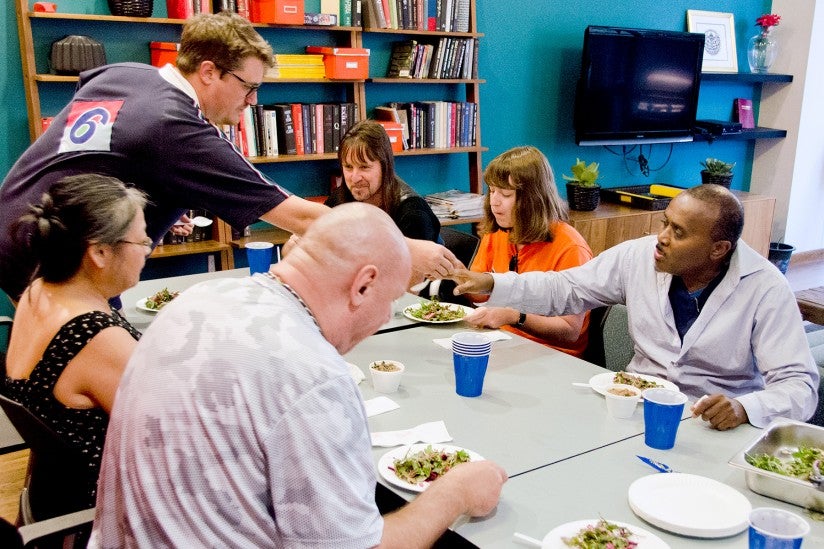
What can be better than good food and conversation? (photo/ Cheryl)
New program for the homeless nourishes body and soul
USC pilot project relies on the time-honored tradition of cooking and sharing a meal with others
USC students and formerly homeless residents living in supportive housing are building a bond by breaking bread.
The time-honored tradition of cooking and sharing a meal with others is at the center of a new program called Nourished that seeks to create community between student volunteers and people who have experienced homelessness in Los Angeles.
The concept is simple enough. USC students gather with residents at a permanent supportive housing facility on the edge of Koreatown once a week to cook healthy recipes and eat together. They share stories and chat about current events.
But interviews and focus groups with residents and volunteers hint at the development of a deeper connection and the cultivation of a sense of belonging.
“The neatest thing is how it brings people out of the housing here and gets them together,” said Fred Banks, a resident who has attended many of the Nourished events. “We might have karaoke or a dance, but when you have a meal with somebody, it’s totally different. It builds relationships and makes people come together more closely.”
Launched as a pilot project earlier this year by researchers at the USC Suzanne Dworak-Peck School of Social Work and leaders at the USC Caruso Catholic Center, the program has focused on going beyond a simple meal program for people who have experienced homelessness.
“Nourished is unique in that it changes people’s lives in a more substantive way than just giving them a meal or trying to meet their immediate needs,” said Jack Lahey, co-founder and program manager of Nourished and a recent graduate of the school’s MSW program. “It can change their perspective on their community and their lives.”
The initiative originated from conversations among Lahey; Benjamin Henwood, an assistant professor at the USC School of Social Work whose research involves homelessness; and officials at the Caruso Catholic Center who sought advice on developing a program that would get USC students involved in issues related to homelessness.
Building bonds
Although they emphasized that charitable programs that provide food and clothing to individuals experiencing homelessness are critical and should continue, Nourished organizers envisioned a program with more of a focused approach to building connections.

“I wanted to move our students toward looking at systemic issues and social justice and to move beyond charity,” said Rosie Shawver, the center’s director of campus ministry. She added later, “Misconceptions are broken when you encounter somebody and build a relationship with them. If you are on Skid Row and handing out sandwiches, that encounter can happen, but it might be shorter and isn’t intentional.”
The initiative is certainly timely. The university recently convened city officials, service providers and other stakeholders to launch a collaborative effort to address homelessness in the region. The program also fits well with the American Academy of Social Work and Social Welfare’s Grand Challenge to End Homelessness, a national effort headed by Henwood and other homelessness scholars.
Nearly 50,000 people experienced homelessness in Los Angeles last year, prompting city officials to declare a state of emergency and earmark $100 million to tackle the issue. The city is slowly shifting from what experts describe as outdated and ineffective shelters to placing individuals in permanent supportive housing, where they receive wraparound services such as ongoing medical and mental health care, case management and referrals to other providers.
Although that approach, known as Housing First, fulfills the needs of many people transitioning from the streets into housing, Lahey said critical gaps remain. Some individuals living in supportive housing struggle to access healthy food and often grapple with loneliness.
“A big barrier for them has always been social isolation and a real lack of community integration,” he said. “By having these meals in a group format in a casual way, we hope to bridge that gap and create a community that extends beyond the housing site and university campus.”
